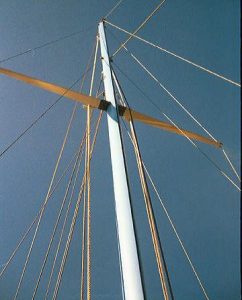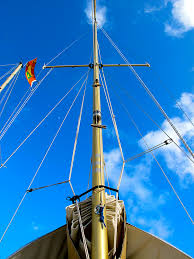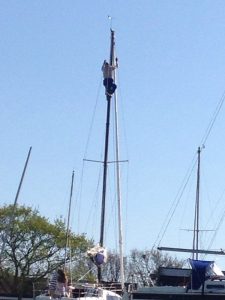The winter lay up period for cruisers is upon us.
Most of our members boats will be coming out of the water over the next 4 weeks. The final recovery date being Sunday 5 November. PLEASE don’t leave it too late to get your boat’s name on a list for one of the recovery days.
To quote Ian’s email to members. “Now is an opportune time to respectfully reminded all owners to “frap-up!“ … please remember to secure all halyards away from the mast in the name of peace & quiet and out of neighborly respect to the folk living next door. Thank you.”
How to do it

Avoid chafe to your halyard ropes and damage to the anodised surface of your aluminium mast by leading all of your halyards away from your mast. Think of creating a tent shape with the halyards from the mast shackled onto stanchion bases or through lines led to cleats around the edge of your boat. Keep them clear of your spreaders too.
How to do it – see the picture above. This boat has the advantage of ‘thumb cleats’ on the spreaders which you can hook your halyards around so they pull the ropes away from the mast. All of the remaining halyards are led well away from the mast which is best for a quiet life with our neighbours too.

How NOT to do it. Bungees are OK for summer, but these are useless to prevent halyard slap above the spreaders in a gale. If your boat looks like this when its laid up, please put the bungees away for the winter and lead all the halyards down to the perimeter of your boat.
Shackle or securely tie them to stanchion bases, toe rails or cleats . If you are stuck for cleats, just use a short line to create a bridle down each side of your boat and then tie/shackle your halyards onto this.
Flagging up some issues

Worth checking your flag halyards. Honestly, its worth it compared with using a ladder or bosun’s chair to go up the mast to perilously replace them next year.
These vibrate in the wind and can chafe through on the edges of small blocks/sheaves on your spreaders or at the mast head during the windy winter months. To replace them can be a real pain in the proverbial come spring time. Check them now and secure them – or even run new ones before the gales start.

